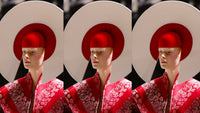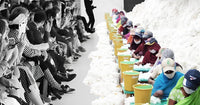Through History: Social Status, Religion, Tradition, and Culture
From medieval times to the present day, headpieces have evolved to represent various symbols and values in different societies.
During the medieval era (12th to 15th centuries), headdresses were crucial for indicating social hierarchy and religious devotion. Noblewomen commonly wore veils and wimples, which signified modesty and piety. These headpieces not only denoted social status but also reflected religious bond, as covering the head was a symbol of devoutness in Christian doctrine. Women of high status would wear more intricate versions embellished with fine fabrics and embroidery to set themselves apart from the commoners.


Medieval wimple & veil
Women decorated themselves with hennins (cone-shaped headdresses) and crespines (netted caps) covered with jewels and intricate designs.

crespine headpiece
The Renaissance brought a shift to more elaborate and decorative headpieces, reflecting the era's focus on art, beauty, and the revival of classical ideals.These accessories served as symbols of wealth and sophistication and were worn during important social events to display one's social standing and taste.
The Baroque period witnessed even more extravagant headdresses. The fontange, a high headdress made of lace, ribbons, and sometimes feathers, gained popularity among the French aristocracy. These elaborate headpieces were statements of opulence and power, often defying practicality. Women also styled increasingly elaborate hairstyles, with headdresses adding height and grandeur to underscore their elevated social position, a 'trend' that continued until the mid 18th century. In France, it was the French Revolution that simplified the way of dressing, opposing the aristocracy, monarchy and the extravagance popularized by Marie Antoinette.
In the Victorian era, headpieces became elaborate once again, especially among the upper classes. Bonnets adorned with flowers, ribbons, and lace were popular. These headpieces served both aesthetic and practical purposes, protecting the face from the sun and conveying a woman's social status. Mourning bonnets made of black crepe were worn to signify grief and respect for the deceased, highlighting the strict social and conservative dress codes of the era.


Fontage from late 17th to early 18th century & Victorian bonnet from 19th century
The early 20th century brought significant changes in women's fashion, including headpieces. The cloche hat, popular in the 1920s, complemented the short bob hairstyles of the era and symbolized modernity and liberation. Headbands adorned with feathers and beads were also fashionable, reflecting the youthful rebellion and flapper culture of the Roaring Twenties. The mid-20th century saw a variety of headpiece styles. The pillbox hat, popularized by Jacqueline Kennedy, became a symbol of elegance and sophistication. The hippie movement of the 1960s and 70s introduced headbands and flower crowns, symbolizing a return to nature and a free-spirited lifestyle.
CONTEMPORARY FASHION
Today, headpieces blend tradition with contemporary fashion. Fascinators, headbands, and hats are popular at events like weddings, royal ceremonies and races but also as editorial piece and runaway statement by many brands.
Worth checking:
Philip Treacy
Isabella Blow
Daphne Guiness

Isabella Blow wearing Philip Treacy
RELIGIOUS SIGNIFICANCE
Headdresses across different religions serve as powerful symbols of faith, modesty, and cultural identity. They reflect the deep spiritual beliefs and practices of individuals and communities, emphasizing the importance of humility, reverence, and commitment to religious principles. Whether through veils, turbans, hijabs, kippahs, or other forms, these headdresses continue to play a vital role in religious expression and cultural heritage.







